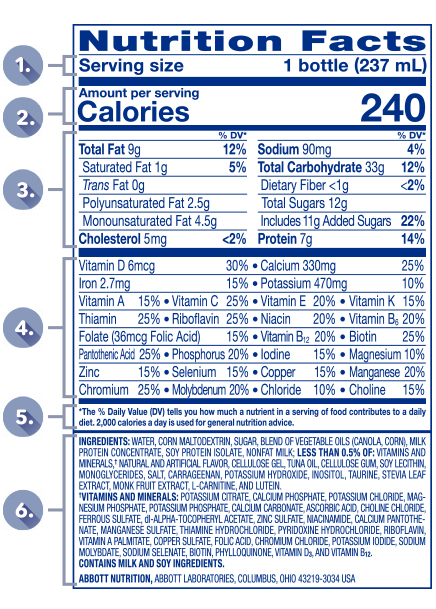38 understanding ingredients on food labels
Food label: ingredient list - Canada.ca Food label: ingredient list The ingredient list shows all the ingredients in a packaged food. Ingredients are listed in order of weight, beginning with the ingredient that weighs the most and ending with the ingredient that weighs the least. How to understand food labels - Eat For Health The Nutrition Information Panel on a food label offers the simplest and easiest way to choose foods with less saturated fat, salt (sodium), added sugars and kilojoules, and more fibre. It can also be used to decide how large one serve of a food group choice or discretionary food would be and whether it's worth the kilojoules.
Easy Tips To Understand The Ingredient List On Food Labels ... Sugar, sodium and saturated and trans fats have a myriad of monikers. Sugar, for example, may appear as sugar, high fructose corn syrup, agave nectar, brown rice syrup, honey, molasses and a slew of words that end in "ose" (think glucose, fructose, maltose and galactose). Worried about sodium?
Understanding ingredients on food labels
How to Read Food Labels Without Being Tricked Food labeling regulations are complex, making it harder for consumers to understand them. This article explains how to read food labels so that you can differentiate between mislabeled junk and ... Understanding Ingredients on Food Labels - EmPOWERED To Serve There are many terms used for sugar on food labels. You might see sugar listed as the fourth ingredient in a product and think it's not so bad. But sugar can also be listed as high-fructose corn syrup or corn syrup, agave nectar, barley malt syrup or dehydrated cane juice, to name just a few. Read more about sugar and sweeteners. Understanding Ingredients on Food Labels | American Heart ... There are many terms used for sugar on food labels. You might see sugar listed as the fourth ingredient in a product and think it's not so bad. But sugar can also be listed as high-fructose corn syrup or corn syrup, agave nectar, barley malt syrup or dehydrated cane juice, to name just a few. Read more about sugar and sweeteners.
Understanding ingredients on food labels. How to Understand and Use the Nutrition Facts Label | FDA Dietary fiber, vitamin D, calcium, iron ad potassium are nutrients on the label that Americans generally do not get the recommended amount of. They are identified as nutrients to get more of.... Food Labels | CDC Understanding the Nutrition Facts label on food items can help you make healthier choices. The label breaks down the amount of calories, carbs, fat, fiber, protein, and vitamins per serving of the food, making it easier to compare the nutrition of similar products. Understanding Food Labels - Food Ingredient Facts Food labels are required to list all ingredients contained in the food in descending order based on the amount found in the final product. Most food additives are therefore found toward the end of the ingredient list. This indicates they are used in very small amounts in the food, generally less than two percent of the product. Understanding Food Labels and Health Claims - Nutrition ... 5 Understanding Food Labels and Health Claims Learn. How to use a Food Label; ... The FDA requires food manufacturers to list their packages if the product contains any of the eight most common ingredients that cause food allergies. These eight common allergens are as follows: milk, eggs, peanuts, tree nuts, fish, shellfish, soy, and wheat. The ...
How to Read a Food Label | Food Allergy Research & Education While all ingredients in a food are supposed to be listed in the ingredients list, FALCPA covers only the eight most common allergens. These are milk, egg, peanut, tree nuts, soy, wheat, fish and crustacean shellfish. Note that molluscan shellfish—such as oysters, clams, mussels or scallops—are not required to be labeled as a major allergen. Understanding Food Nutrition Labels - Professional Heart ... When the Nutrition Facts label says a food contains "0 g" of trans fat, but includes "partially hydrogenated oil" in the ingredient list, it means the food contains some trans fat, but less than 0.5 grams per serving. So, if you eat more than one serving, you could end up eating too much trans fat. Food Labeling & Nutrition | FDA Food labeling is required for most prepared foods, such as breads, cereals, canned and frozen foods, snacks, desserts, drinks, etc. Nutrition labeling for raw produce (fruits and vegetables) and... Labels - Understanding ingredient labels - Center for ... Ingredients will always be listed from the largest to smallest quantity based on weight regardless of the product. However, each product has specific differences. Cosmetic labels provide an overview of what the product does, the ingredients in the product, and any allergens (e.g., nut oils, etc.).
Understanding Food Labels PDF | Food Allergy food labels? No. The only foods that have to be declared are those the FDA considers major food allergens: milk, wheat, egg, peanuts, tree nuts, fish, crustacean shellfish, and soy, or ingredients that contain proteins from these foods. Do major food allergens contained in dyes (food coloring), spices, flavorings, additives and processing Understanding Ingredients on Food Labels - Professional ... There are many terms used for sugar on food labels. You might see sugar listed as the fourth ingredient in a product and think it's not so bad. But sugar can also be listed as high-fructose corn syrup or corn syrup, agave nectar, barley malt syrup or dehydrated cane juice, to name just a few. Read more about sugar and sweeteners. How to Read and Understand Ingredient Labels (and Why ... Scattered throughout the ingredient label are several sugars, including brown sugar, sugar, malted barley extract, corn syrup, oligofructose, polydextrose, corn syrup solids, invert sugar, molasses, sucralose … and the chocolate chips and rice crisps probably have some sort of sweetener in them as well. Understanding Ingredients In Food Labels - EUFIC The quantity of a product's main or characterising ingredients must be declared, usually as a percentage, when the ingredient (or category of ingredient) appears in the name of the food, is normally associated with that food, or is given particular emphasis in the label (e.g. highlighted or pictured). Explaining ingredients
PDF Understanding Food Labels! - University of Arizona Understanding Food Labels! The following pages contain some great information about the food labels that come on all of the food packaging that you buy. Choosing a packaged food or beverage that's right for you is easier when you check out the "Nutrition Facts" label.
Understanding Food Labels | The Nutrition Source | Harvard ... Under the Food Allergen Labeling and Consumer Protection Act of 2004, eight major food allergens—milk, fish, tree nuts, peanuts, shellfish, wheat, eggs, and soybeans—are required to be listed in a "contains" statement near the Ingredients list if present in a food. An example would be "contains wheat, milk, and soy."
Understanding Food Nutrition Labels | American Heart ... Learning how to understand and use the Nutrition Facts label can help you make healthier eating choices and identify nutrient-dense foods for a healthy diet. Here are some tips from the American Heart Association for making the most of the information on food labels. Learn what to look for on the label.
Understanding Food Labels, Part II: The Ingredient Statement Understanding Food Labels Part II: The Ingredient Statement. Karin Allen, Ph.D., Food Quality & Entrepreneurship Specialist. Food Labels Can Be Confusing... But Ingredient Statements look like they're written . in a foreign language! Essentially, they are. It's the language of food scientists, chemists, and processors,
Understanding Ingredients on Food Labels | Ingredient list Understanding Ingredients on Food Labels | Ingredient list Ingredients are listed in order of quantity, but that doesn't always tell the whole story. For example, if a jar of salsa lists tomatoes first, you know there are more ...
Understanding Food Labels - Food & Water Watch Country of Origin Labels. For now, the United States requires Country of Origin Labeling (COOL) on chicken, seafood, produce and some nuts that tells us basic information about what country our food was produced in - but the food industry has limited even this most basic element of transparency. Until late 2015, beef and pork were also ...
How To Read Food and Beverage Labels | National Institute ... There are three types of product dates commonly printed on packaged foods and beverages: "Sell by" tells how long the manufacturer suggests that a store should sell items such as meat, poultry, eggs, or milk products. Make sure you buy by this date. "Use by" tells how long items will be at peak quality.
Reading & Interpreting Ingredient Lists on Food Labels ... The ingredients are listed by weight; the ingredient that has the highest weight is listed first, and the ingredient with the lowest weight is listed last. This is important as we examine which...






Post a Comment for "38 understanding ingredients on food labels"